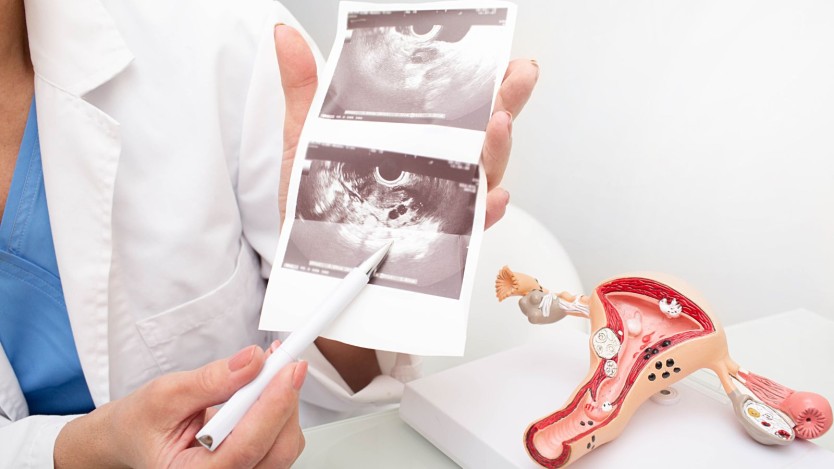Uterine fibroids and pregnancy

- Relationship of uterine fibroids and pregnancy
- The link between infertility and uterine fibroids
- Relationship between infertility and uterine fibroids
- What are the mechanisms through which uterine fibroids and pregnancy are related?
- Types of uterine fibroids and its relationship to pregnancy
- Women who suffer from uterine fibroids are more likely to have problems getting pregnant.
- Depending on the type of uterine fibroid you have, there will be different pregnancy-related problems.
- Submucous uterine fibroids cause the most serious problems in conceiving.
Relationship of uterine fibroids and pregnancy
A uterine myoma is a pelvic tumour that sits in one of the layers that make up the uterus in women. This pelvic tumour is benign in the vast majority of cases and the symptoms it causes are due to its growth towards the inside of the uterus or towards the outside of the uterus, causing alterations in the adjacent structures.
There are several types of uterine fibroids, depending on the layer of the uterus from which they develop. Depending on the type of uterine fibroids, there will be a more or less direct relationship with pregnancy.
Uterine fibroids often cause anatomical alterations of the woman's uterus that can lead to alterations in the ability to conceive. It has been established that there is a direct relationship between women with multiple miscarriages and the presence of uterine fibroids in them, as well as in the prevalence of sterility.

Do you need myomectomy surgery?
Request a free and immediate appointment with our specialists
The link between infertility and uterine fibroids
Infertility is defined as the inability of a couple to achieve pregnancy after one year of trying to conceive without the use of contraception. This definition, like everything in medicine, must be individualised for each couple and should not be followed categorically.
It is estimated that 80% of couples under the age of 35 should become pregnant in the first year of seeking conception without the use of contraception.
The relationship between uterine fibroids and pregnancy, in this case the lack of pregnancy or sterility, is weaker than if we compare it with infertility, as we will see below. It is estimated that only 5% of the causes of infertility are directly attributed to the presence of uterine fibroids.

Infertility is considered primary when the couple has never conceived a son or daughter and secondary when after one or more full-term pregnancies no conception has occurred in 2 years of searching.
Relationship between infertility and uterine fibroids
Infertility is defined as the inability to achieve pregnancy or, once a pregnancy has been achieved, the impossibility of carrying it to term.
In this way we can also differentiate between primary and secondary infertility, with primary infertility occurring when there has not been a full-term pregnancy previously and secondary infertility when, having had children, the circumstances mentioned above occur.

The relationship between infertility and uterine fibroids and pregnancy is stronger than the one described in the previous section with sterility.
It is estimated that between 10% and 15% of infertility problems have or have as a fundamental cause the presence of uterine fibroids in the woman's womb.
Types of uterine fibroids and its relationship to pregnancy
As we have already mentioned, the presence of uterine fibroids is reflected in alterations in the normal course of pregnancy or in the difficulty that some couples have in conceiving.
We will now describe the relationship between each of the types of uterine fibroids and their particular impact on pregnancy.

- Subserosal uterine fibroids: these are fibroids that grow from a layer of the uterus called serosa, which is located in the outermost part of the uterus. These fibroids have little to do with pregnancy, as their usual symptoms are due to their growth towards the outside of the uterus and their relationship with the surrounding organic structures.
- Intramural uterine fibroids: these uterine fibroids are the most frequent in terms of prevalence. The relationship between these fibroids and pregnancy is due to alterations in the vascularisation of the uterus and their size, as they are the ones that grow in the greatest quantity and distort the uterine cavity to a greater extent. The removal of these uterine fibroids partially improves the possibility of conception and achieving a viable pregnancy in couples with problems such as sterility or infertility.
- Submucosal uterine fibroids: these are fibroids that grow in relation to the endometrium of the uterus, the innermost layer of the uterus and the most proliferative as it is the one that grows during the ovulatory cycle and the one that is shed during menstruation. This layer is also the one that will develop to accommodate the embryo and promote its growth. The relationship of submucosal uterine fibroids to infertility and pregnancy problems is the strongest of all the types of fibroids encountered. Removal of these uterine fibroids is most strongly associated with improved pregnancy rates in women who have them.

Do you need myomectomy surgery?
Request a free and immediate appointment with our specialists in Gynaecology
Uterine fibroids not only cause disturbances in the phases prior to conception and in the first weeks of pregnancy, but are also of great importance in the final stages of pregnancy. In this regard, they may increase in size or cause abdominal pain due to degeneration in the last weeks of pregnancy.
In addition, a higher frequency of intrauterine growth retardation, premature rupture of membranes, preterm labour, miscarriage, postpartum haemorrhage and caesarean section has been observed in women suffering from uterine fibroids during pregnancy.
Medical disclaimer: All the published content in Operarme is intended to disseminate reliable medical information to the general public, and is reviewed by healthcare professionals. In any case should this information be used to perform a diagnosis, indicate a treatment, or replace the medical assessment of a professional in a face to face consultation. Find more information in the links below:
